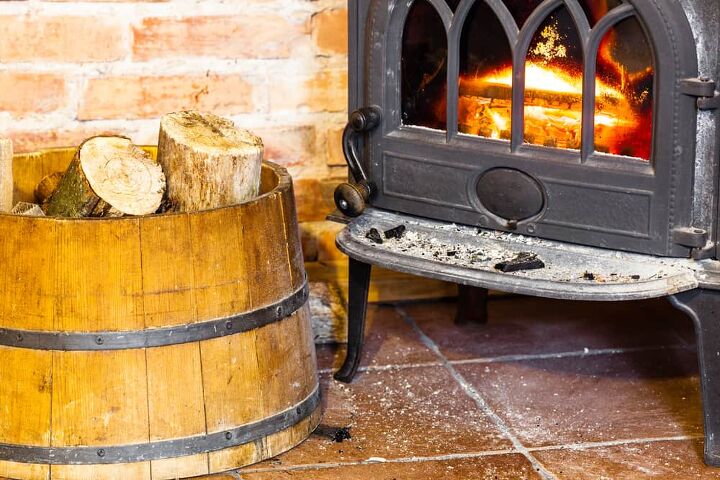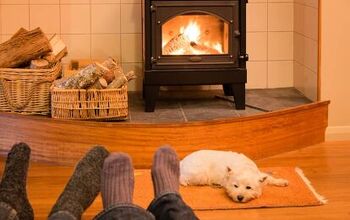How To Get The Most Heat From Wood Burning Stoves

Wood burning stoves are excellent for heat production to keep your home nice and warm, especially in the winter months. However, that’s not to say that there’s a little bit of knowledge that you should have under your belt to help get the most heat from your stove.
Put 1-3 wood logs into the stove regularly to increase the heat and make the fire last longer. Adjust the damper above the stove so that it is fully open to increase airflow and make the fire burn hotter. Clean your wood burning stove after each use to get the most of it and burn hardwood.
This article will walk you through the best ways to get the most heat from your wood-burning stove. Perhaps you can use these methods to keep your home warm when the fall and winter months come.
It’s Not Just About Heat
While getting the most heat from your wood stove is essential, it’s not necessarily just about the amount of heat. These tips will help your wood burn more efficiently, which means that you’ll burn less wood over a more extended time.
In turn, the embers that your fire creates will put off more heat. So, it’s a win-win situation! You have the best heat output, and it helps save you in the long run on maintenance and operating costs.
Maintain The Fire
Interestingly, an effective method of increasing the overall heat generated by your wood-burner is maintaining the fire burning firmly and steadily. By feeding a few logs at regular intervals, the fire doesn’t lose its power.
Try this instead of packing wood into the fire at short intervals. Also, don’t let it burn down to almost nothing before throwing in any more logs Aiming to create a layer of red-hot embers with a couple of logs sitting on top will produce a considerable level of heat. This heat can then be distributed throughout your home.
Regulate The Damper
If your stove has a damper, you’ll typically find it above the stove, inside the flue. Its function is to control airflow as it leaves the stove by adjusting the draw from the flames. By having the damper open when you’re using the stove, you allow smoke and gases to be expelled outside your home.
Safety point: Never close the damper off entirely either when the stove is in use or for an extended time after use. If you do, smoke and toxic gases could enter your home.
Burn Well Seasoned Wood
To get the maximum benefit from your wood-burner, your firewood must be correctly dried. Firewood appropriate to burn in a wood stove is commonly defined as ‘well-seasoned’ or ‘kiln-dried.’ Keep your eyes open for these descriptions when you buy wood.
‘Well-seasoned’ wood is that which has been allowed to dry out over an extended period, thereby allowing any moisture in the logs to evaporate so that they’re easy to burn. Typically, this process will require at least six months in softwoods and a year for hardwoods.
Obtaining Maximum Results
To obtain optimum results, select logs that contain a maximum of 20% moisture content. If it is any higher than this, you’ll find that the firewood doesn’t burn easily and will give off less heat in your stove.
The main advantages of selecting well-seasoned firewood wood over that with high moisture content are that they:
- Are easy to ignite
- Produce more powerful flames
- Have a longer burn time
- Create more heat
- Contain less smoke output
Use Hardwoods Over Softwoods
Lighting softwoods is much easier than hardwoods, and they burn more readily. This means that they’re especially useful for the initial stages of your fire. Ideal for kindling, you can also add them as the first few logs as they help get the fire moving and raise the stove’s internal temperature. However, they burn much faster than hardwoods.
A hardwood blaze will be longer-lasting and generate more heat than softwoods. Use them in place of softwoods as soon as the fire has established itself. With a higher density than softwoods, hardwoods create hotter embers which generate heat for extended periods.
Ensure Adequate Room Ventilation
Adequate room ventilation is essential to make sure that the fire has an adequate supply of oxygen. It will also optimize the draft to the flue. If your fire seems to be struggling, it may need more fresh air.
Whenever possible, keep room doors open and even open the window one or two centimeters. Sufficient ventilation within the room is vital to ensure that plenty of oxygen gets to the fire and helps improve the draft up the flue.
Keep The Door Closed
It may seem obvious, but most wood-burners are intended to be operated with the door closed. Leaving the door open doesn’t increase the amount of heat generated. Also, it will negatively impact how the stove functions.
By closing the door, the flow of air is regulated by air vents. These vents are the mechanism that should be used to control the flow of air into the stove’s interior, not the door. When you open the door, you increase the airflow, but this leads to the wood burning more rapidly and heat being lost as the air carries it up the flue.
Fueling The Fire
Also, constantly opening the door to feed the fire with small amounts of wood will disturb the airflow, interfering with the stove’s internal temperature. This is another reason why it’s best to add only a couple of larger logs at one time and minimize the number of times you open the door.
Some wood-burners have more than one set of air vents that you can manually open or shut, controlling the stove’s airflow. Adjusting the vents helps to control the amount of oxygen supplied to the fire. This influences how fast the wood burns and the amount of heat generated by the stove.
Clean & Maintain The Stove
It’s essential to thoroughly clean your wood burner from time to time, making sure that all the air vents are clean and not blocked by ashes. It’s not necessary to clean all the ash out of your stove after every use. When wood is burned on a bed of ash, it burns more efficiently.
Equally, don’t let ash build up to a level where it becomes problematic. One or two centimeters is ideal. When you clean, take care to keep ash or wood fragments away from air vents, so you won’t have problems with airflow the next time you use your stove.
Keep Your Flue Clean
Your flue should be cleaned according to the manufacturer’s recommendations. This should be carried out annually, preferably before the onset of winter. However, if you regularly use your wood-burner, you may need to sweep the flue every three months.
If your flue is dirty, it will prevent the stove from ‘drawing’ effectively. If it’s entirely or even partially blocked, its diameter will be reduced, impeding the possible draft.
Related Questions
Why is my wood burning stove not getting hot?
Your fire needs oxygen so that it can burn through your wood. Open the air vents on your stove to allow more oxygen into the fire. If there’s no oxygen, the fire will smolder and possibly burn out.
Can you get a wood stove too hot?
Yes, a wood stove can get too hot. If it overheats, it can damage your stove as well as adjacent structures. This occurrence has been known to cause chimney and house fires.
Can you put too much wood in a wood stove?
If you put too much wood in your stove, you’ll have to damp down your fire, which will cause it to burn inefficiently. Stuffing your wood stove before bed isn’t going to keep your house warm. Make sure you use hardwood instead of soft and allow adequate airflow.
Our Summary
While wood stoves are lovely for keeping your home warm, there are a few things that you need to do to ensure that your fire burns more efficiently. The efficient burning will help produce more heat and cut back on the costs you spend on wood. By following these tips, you’ll get the best use out of your stove as well.

Heather is a passionate writer who loves anything DIY. Growing up, she learned everything from home repairs to design, and wants to share her tips with you. When she's not writing, she's usually hiking or searching for her next DIY project.
More by Heather Robbins












![The 10 Best Table Saws - [2022 Reviews & Buyer's Guide]](https://cdn-fastly.upgradedhome.com/media/2023/07/31/9070645/the-10-best-table-saws-2022-reviews-buyer-s-guide.jpg?size=350x220)
![The 5 Best Angle Grinders – [2022 Reviews & Buyer's Guide]](https://cdn-fastly.upgradedhome.com/media/2023/07/31/9071326/the-5-best-angle-grinders-2022-reviews-buyer-s-guide.jpg?size=350x220)
![10 Best Zero Turn Mowers – [2022 Reviews & Ultimate Buyer's Guide]](https://cdn-fastly.upgradedhome.com/media/2023/07/31/9070522/10-best-zero-turn-mowers-2022-reviews-ultimate-buyer-s-guide.jpg?size=350x220)












